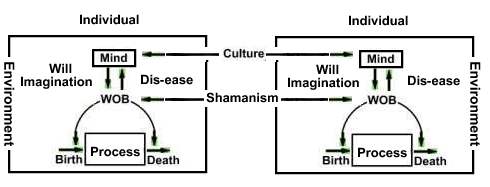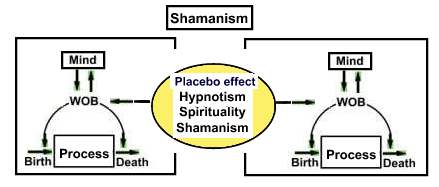
 |
Before reading this chapter please start with:
First concepts
WOB is optimal
Instinct
There are several definitions of Instinct.
- Inherited pattern of responses or reactions to certain kinds of situations.
- A propensity prior to experience, and independent
of instructions.
- A powerful motivation
or impulse.
- In animals instincts generally serve to set in motion mechanisms that evoke
an organism to action, like in animal courtship, or social behavior of ants
and bees.
The language instinct
The meaning of instinct has been recently broadened
to include innate faculties which emerge during child development. Like the
language instinct, which according to Steven Pinker is an innate capacity for language.
The growing child applies the language instinct to learn talking.
One wonders, if language is an instinct, why does
it take most infants as long as three years to learn to talk? Why isn't the
baby born talking? First, the baby
has to learn how to control muscles involved in talking.
Above all it has to grow a mind. The newborn is a pure WOB,
without a mind, and talking requires a mind.
The music instinct
The music instinct belongs to the same category The
vast majority of people throughout the world spend a significant part of their
lives listening to music. The human brain is designed to connect certain forms
of auditory signals with pleasurable sensations. Music inspires in us feelings of happiness,
melancholy, and other emotions. It may even generate an intense pleasurable experience
described as thrill. All this emerges
from our innate faculty to enjoy music.
It takes more than a music instinct to become a fiddler like Isaac Stern or
Itzhak Perlman. This virtuosity require an
insight which many lack. However,
without our innate faculty to enjoy music, Perlman’s virtuosity would be
meaningless to us.
Shamanism
The Shaman instinct
exploits the faculty of WOB to heal itself. Although we all carry the faculty of shamanism,
not all of us gain the expertise of a shaman. The virtuosity of the shaman
requires an insight into the nature of self healing, which
he applies to the sufferers. However, without our innate faculty of
shamanism we could not benefit from the healing power of the shaman.
Shamanism underlies any medical treatment.
The visit to a doctor is instinctively and subconsciously
recast as a visit to a shaman. Whatever
the doctor undertakes has a shamanistic connotation. It is manifested by the
placebo effect, which is regarded instinctively as a healing shamanistic
ritual.
In order to exercise his healing skills, the shaman has first
to alter his state of consciousness. While
the shaman may exercise these two faculties at will, most of us have to practice
in order to master them. The
word shaman originated among the Siberian Tungus and
literally means he who knows. The shaman knows how to communicate
with our shaman instinct.
The biological and medical interpretation of shamanism are discussed in:
2. Medical interpretation of Shamanism
We shall be interested only in messages from one WOB to another, which are
medically meaningful. They either
induce disease states or relieve
them. Such messages are called shamanistic.
Shamanism is an inborn faculty of our body like animal behavior. It enables
communication between different WOB. It underlies an unconscious interaction between healer
and sufferer (patient), and is not mediated by the mind. Shamanism accompanies
humankind ever since it became conscious of itself. Shamans were the first
healers, and their heritage guides many
healers today. What distinguished a shaman from other members of his
tribe was his capability to alleviate suffering. This kind of shamanism is regarded here as genuine, or
primary.
Pagan shamanism
When shamans started to explain
their faculty rationally, they founded the first religion, pagan shamanism,
from which other religions later evolved. Pagan shamanism involves the mind.
Shamanistic symbols and metaphors are interpreted by the mind and transmitted to WOB which then modifies
its processes . Many metaphors
are effective yet some have adverse effects, and induce
mind diseases. Particularly the notion of evil spirits which
cause evil diseases, which have to be purged, and exorcised. A sentence
by a modern shaman stating that "people who are not powerful-spiritually
are prone to illness, accidents, and bad luck" initiates a slippery
slope which ends in mind
diseases caused by religion.
WOB has two meanings. It is the set of all processes in the body, and also their
controller, hence its name:
Wisdom of the Body. We shall
be less concerned with how WOB controls processes, since WOB is
optimal and we hardly comprehend its
wisdom. Rather we intend to listen
to WOB messages, like dis-ease, which indicate that it needs assistance. We shall distinguish
between outgoing messages
which indicate WOB state, and ingoing messages, which interact with its biophysical processes.
There are four kinds of ingoing messages:
1. Direct messages from the mind, which transmit its will to WOB.
2. The effect of the environment.
3. Messages from other minds reaching WOB indirectly (culture).
4. Direct messages from one WOB to another (animal behavior).
Each such message modifies biophysical processes in WOB. For instance:
1. In order to raise my hand, my mind transmits my will to WOB which then executes it.
2. When it gets cold, environment induces WOB to shiver.
3. When one mind hears the
other mind saying "I love you!" it
translates this message and
transmits it to WOB, which modifies some of its biophysical processes. Generally culture is a set of messages transmitted from mind to mind, which initiate process modifications executed
by WOB.
4. Animal behavior, like courtship are messages from one WOB to
another, which affect its processes.
 |
Shamanism includes also phenomena
like, spirituality, hypnotism and placebo effect, which are innate
and hardwired in WOB
 |
3. Making Placebo respectable.
4. Scientific framework for
the placebo effect.
5. Placebo and Cancer.
6. A history of God and disease
7. A shaman who treats cancer .